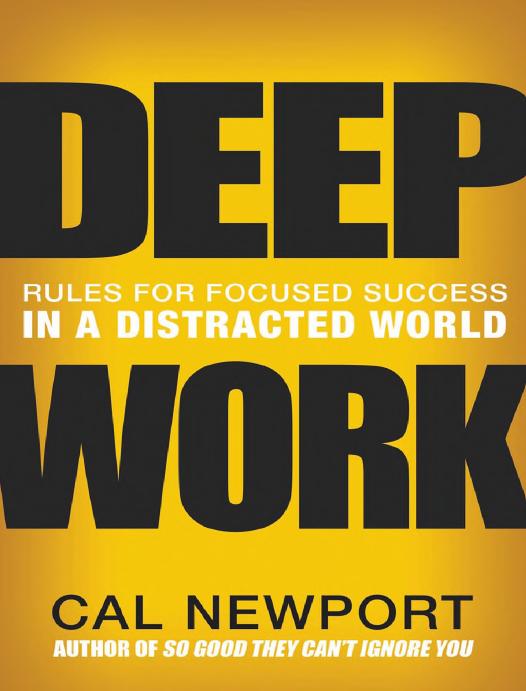Deep Work by Cal Newport

Author:Cal Newport
Language: eng
Format: epub, mobi, pdf
Tags: Business & Economics / Time Management
Publisher: Grand Central Publishing
Published: 2016-01-04T16:00:00+00:00
Rule #2
Embrace Boredom
To better understand how one masters the art of deep work, I suggest visiting the Knesses Yisroel Synagogue in Spring Valley, New York, at six a.m. on a weekday morning. If you do, you’ll likely find at least twenty cars in the parking lot. Inside, you’ll encounter a couple dozen members of the congregation working over texts—some might be reading silently, mouthing the words of an ancient language, while others are paired together debating. At one end of the room a rabbi will be leading a larger group in a discussion. This early morning gathering in Spring Valley represents just a small fraction of the hundreds of thousands of orthodox Jews who will wake up early that morning, as they do every weekday morning, to practice a central tenet of their faith: to spend time every day studying the complex written traditions of Rabbinic Judaism.
I was introduced to this world by Adam Marlin, a member of the Knesses Yisroel congregation and one of the regulars at its morning study group. As Marlin explained to me, his goal with this practice is to decipher one Talmud page each day (though he sometimes fails to make it even this far), often working with a chevruta (study partner) to push his understanding closer to his cognitive limit.
What interests me about Marlin is not his knowledge of ancient texts, but instead the type of effort required to gain this knowledge. When I interviewed him, he emphasized the mental intensity of his morning ritual. “It’s an extreme and serious discipline, consisting mostly of the ‘deep work’ stuff [you write about],” he explained. “I run a growing business, but this is often the hardest brain strain I do.” This strain is not unique to Marlin but is instead ingrained in the practice—as his rabbi once explained to him: “You cannot consider yourself as fulfilling this daily obligation unless you have stretched to the reaches of your mental capacity.”
Unlike many orthodox Jews, Marlin came late to his faith, not starting his rigorous Talmud training until his twenties. This bit of trivia proves useful to our purposes because it allows Marlin a clear before-and-after comparison concerning the impact of these mental calisthenics—and the result surprised him. Though Marlin was exceptionally well educated when he began the practice—he holds three different Ivy League degrees—he soon met fellow adherents who had only ever attended small religious schools but could still “dance intellectual circles” around him. “A number of these people are highly successful [professionally],” he explained to me, “but it wasn’t some fancy school that pushed their intellect higher; it became clear it was instead their daily study that started as early as the fifth grade.”
After a while, Marlin began to notice positive changes in his own ability to think deeply. “I’ve recently been making more highly creative insights in my business life,” he told me. “I’m convinced it’s related to this daily mental practice. This consistent strain has built my mental muscle over years and years. This was not the goal when I started, but it is the effect.
Download
This site does not store any files on its server. We only index and link to content provided by other sites. Please contact the content providers to delete copyright contents if any and email us, we'll remove relevant links or contents immediately.
| Bookkeeping | Business Mathematics |
| Business Writing | Communications |
| Decision Making | Negotiating |
| Project Management | Running Meetings & Presentations |
| Secretarial Aids & Training | Time Management |
| Training |
Nudge - Improving Decisions about Health, Wealth, and Happiness by Thaler Sunstein(6732)
Deep Work by Cal Newport(5684)
Principles: Life and Work by Ray Dalio(5458)
The Doodle Revolution by Sunni Brown(4120)
Factfulness: Ten Reasons We're Wrong About the World – and Why Things Are Better Than You Think by Hans Rosling(4110)
Thinking in Bets by Annie Duke(3623)
Eat That Frog! by Brian Tracy(3620)
Hyperfocus by Chris Bailey(3372)
Writing Your Dissertation in Fifteen Minutes a Day by Joan Bolker(3347)
Visual Intelligence by Amy E. Herman(3329)
How to Win Friends and Influence People in the Digital Age by Dale Carnegie & Associates(2931)
How to win friends and influence people by Dale Carnegie(2925)
Hidden Persuasion: 33 psychological influence techniques in advertising by Marc Andrews & Matthijs van Leeuwen & Rick van Baaren(2871)
Schaum's Quick Guide to Writing Great Short Stories by Margaret Lucke(2858)
The Pixar Touch by David A. Price(2809)
Ogilvy on Advertising by David Ogilvy(2774)
Work Clean by Dan Charnas(2616)
The Slow Fix: Solve Problems, Work Smarter, and Live Better In a World Addicted to Speed by Carl Honore(2610)
The Content Trap by Bharat Anand(2543)
